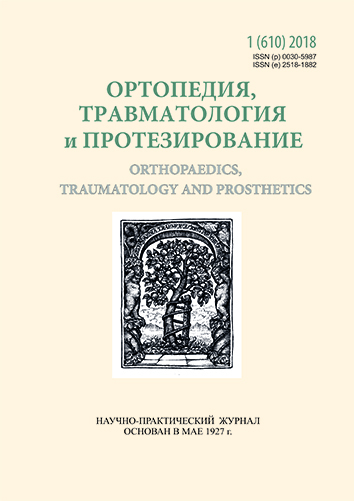Characteristics of stress-strain foot model before and after subtalar arthroereisis with implants at the treatment of flatfoot (message 2)
DOI:
https://doi.org/10.15674/0030-59872018165-71Keywords:
foot, flat-valgus foot, arthroereisis, mathematic modelingAbstract
One of the modern types of flatfoot surgical treatment is subtalar arthroereisis with implant placement in sinus tarsi. There are a lot of kinds of such implants.
Objective: to study stress-strain state of the foot bone elements in normal and in cases of its flatfoot deformity before and after implant placement.
Methods: we made finite element model which consist of tibia, fibula, talus, calcaneus, navicular and cuneiform bones. Joint surfaces were modeled with mechanical properties of cartilage tissue. We compared two types of models-conical and cylinder, also made assessment of mechanical properties (titanium, sapphire, carbon) on stress-strain state.
Results: using of implants with conical and cylinder shape led to increasing of stress values in the place of contact with the bone, especially on the subtalar surface 8,0 и 7,1 МPа. Difference in stress values on the all areas of the foot model with both implants is not significant, but at cylinder shape implantation we observed quantitatively better indexes improvement. Implant material does not influence on the strain distribution in the foot bones.
Conclusions: using of implants for subtalar arthroereisis can influence positively on strain distribution of the foot at its surgical correction. Subtalar arthroereisis is one of the kinds for flatfoot deformity treatment and ankle joint stabilization.
References
- Korolkov, O., Rakhman, P., Karpinsky, M., Shishka, I., & Yaresko, O. (2018). Assessment of stress-strain distribution in flatfoot deformity (part 1). Orthopaedics, Traumatology and Prosthetics, 4, 80-84. doi: https://doi.org/10.15674/0030-59872017480-84. (in Ukrainian)
- Koning, P. M., Heesterbeek, P. J., & De Visser, E. (2009). Subtalar Arthroereisis for Pediatric Flexible Pes Planovalgus. Journal of the American Podiatric Medical Association, 99(5), 447-453. doi: https://doi.org/10.7547/0990447.
- Rodriguez, N., Choung, D. J., & Dobbs, M. B. (2010). Rigid Pediatric Pes Planovalgus: Conservative and Surgical Treatment Options. Clinics in Podiatric Medicine and Surgery, 27(1), 79-92. doi: https://doi.org/10.1016/j.cpm.2009.08.004.
- Tamoyev, S. K. (2012). The subtalar arteries in the static treatment of flatfoot deformity in adults (PhD thesis). Moscow. (in Russian)
- Korolkov, O., Rakhman, P., & Kikosh, G. (2016). Subtalar arthroeresis in the treatment of planovalgus feet deformity: the pros and cons (the review of literature). Orthopaedics, Traumatology and Prosthetics, 1, 115-123. doi: https://doi.org/10.15674/0030-598720161115-123 (in Russian)
- Vogler, H. M. (1987). Subtalar joint blocking operations for pathological pronation syndromes. In E. D. McGlamry (Ed.), Comprehensive textbook of foot surgery (pp. 447–465). Baltimore: Williams & Wilkins.
- Sinelnikov, R. D., & Sinelnikov, R. J. (1996). Atlas of human anatomy. Textbook. benefit. Moscow: Medicine. (in Russian)
- Soomekh, D. J., & Baravarian, B. (2006). Pediatric and adult flatfoot reconstruction: subtalar arthroereisis versus realignment osteotomy surgical options. Clinics in Podiatric Medicine and Surgery, 23(4), 695-708. doi: https://doi.org/10.1016/j.cpm.2006.08.003
- Flynn, J., Wade, A., Bustillo, J., & Juliano, P. (2014). Bridle Procedure Combined With a Subtalar Implant. Foot & Ankle Specialist, 8(1), 29-35. doi: https://doi.org/10.1177/1938640014548319
- Korolkov, O. I., Rakhman, P. M., & Kykosh, G.V. (2017). Implant for subtalar joint stabilization in the treatment of flat foot deformation .Ukraine. Pat. 113131. (in Ukrainian)
- Agapov, V. P. (2000). Finite element method in statics, dynamics and stability of thin-walled spatial supported structures : textbook. Moscow: ASV (in Russian)
- Berezovskiy, V. A., & Kolotilov, N. N. (1990). Biophysical characteristics of human tissues: Handbook. Kiev: Naukova Dumka. (in Russian)
- Gere, J. M., & Timoshenko, S. P. (1997). Mechanics of material.
- Zenkevich, O. K. (1978). Finite element method in engineering. Moscow: Mir. (in Russian)
- Alyamovskii, A. A. (2004). SolidWorks/COSMOSWorks. Engineering analysis by finite element method. Moscow: DMK Press. (in Russian)
Downloads
How to Cite
Issue
Section
License
Copyright (c) 2018 Oleksandr Korolkov, Paviel Rakhman, Mykhaylo Karpinsky, Igor Shishka, Oleksandr Yaresko

This work is licensed under a Creative Commons Attribution 4.0 International License.
The authors retain the right of authorship of their manuscript and pass the journal the right of the first publication of this article, which automatically become available from the date of publication under the terms of Creative Commons Attribution License, which allows others to freely distribute the published manuscript with mandatory linking to authors of the original research and the first publication of this one in this journal.
Authors have the right to enter into a separate supplemental agreement on the additional non-exclusive distribution of manuscript in the form in which it was published by the journal (i.e. to put work in electronic storage of an institution or publish as a part of the book) while maintaining the reference to the first publication of the manuscript in this journal.
The editorial policy of the journal allows authors and encourages manuscript accommodation online (i.e. in storage of an institution or on the personal websites) as before submission of the manuscript to the editorial office, and during its editorial processing because it contributes to productive scientific discussion and positively affects the efficiency and dynamics of the published manuscript citation (see The Effect of Open Access).














